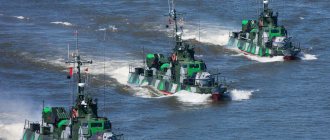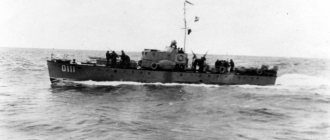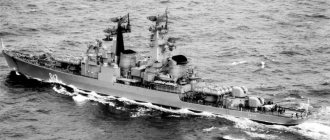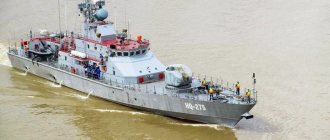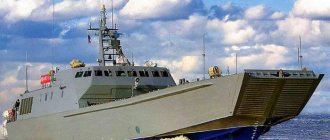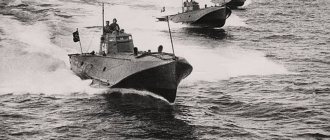The Soviet Union is rightfully considered the ancestor country of such a class of warships as missile boats. The naval concept for the development of the fleet, developed in the depths of the Supreme Naval Leadership, provided for equipping the fleet with small combat vessels, which in terms of weapon power were comparable to ships in the far sea zone. The creation of a “mosquito fleet” made it possible to create effective means of defense of sea borders in a short time and at fairly low costs. High speed, stealth and powerful missile weapons made such ships truly dangerous opponents for any warship.
The appearance of missile boats at sea negated the advantages of a large ocean-going fleet in the coastal sea zone. Subsequent historical events showed the correctness of the developed concept. The missile boats created by Soviet designers became a “revolutionary breakthrough” in the history of world military shipbuilding. Despite their small displacement, thanks to their high speed and powerful weapons, ships of this class were classified as corvettes in the Western classification. Missile boats of the Project 1241 type, which were built at domestic shipyards over the course of 17 years, are rightfully considered one of the best representatives of ships of this class.
Background to the appearance of Project 1241 boats
It should be noted that the idea of creating a “mosquito fleet” is not new. Even on the eve of the First World War, some European states sought to strengthen their own naval forces by building small, high-speed combat ships. At that time, the main armament of ships of this class was mine weapons. The successful use of torpedo boats by Italian sailors during a naval war with a stronger enemy showed the great capabilities of a small fleet. From the category of a fleet for the poor, the “mosquito fleet” has moved into the category of the most effective tools for conducting combat operations in the coastal sea zone.
After the end of World War II, the same idea began to be developed in the Soviet Union. While modern navies have learned to effectively combat torpedo and mine weapons, the advent of missiles has opened up new horizons for warfare at sea. Ships with a small displacement, high speed and armed with anti-ship missiles could become a reliable shield in the defense of ports and fleet bases. Particularly attractive was the opportunity to install combat missiles on a moving platform with a high speed.
The first sign was the Komar-class missile boat, which was actively built in Soviet shipyards for 3 years, from 1959 to 1961. In such a short period of time, up to 100 warships were launched, each of which carried two SS-N-2A Styx anti-ship cruise missiles.
It was these warships that were the first to demonstrate their effectiveness in practice. During the Six-Day Arab-Israeli War of 1967, an Egyptian Komar-class missile boat managed to sink the Israeli destroyer Eilat. This was the reason for the intensive and massive construction of ships of this class all over the world. Third world countries, which could not afford to build or maintain large navies, paid special attention to new weapons.
The Soviet Union was considered the clear favorite in this arms race. By that time, the USSR Navy already had a fairly large number of missile boats of various types in service. New, more powerful vessels were being developed, capable of performing a wider range of tactical tasks. The pinnacle of design thought was Project 1241, a new Tarantula-class missile boat.
The main idea behind the creation of the project
The huge losses suffered by the Soviet Union in World War II posed a difficult task for the Soviet government. There was an urgent need to strengthen the navy with new warships. The economy was unable to build large ocean-going ships, cruisers and aircraft carriers. At the same time, the country urgently needed to strengthen its maritime borders. A way out of this situation could be missile boats, small-displacement combat vessels, high speed and capable of carrying powerful strike weapons.
The idea to create a highly mobile, high-speed combat platform for anti-ship missiles quickly turned into metal. The Soviet Union became the first country in the world to begin building missile boats, a completely new class of military vessels. The combat capabilities of the new class of ships turned out to be so broad that they began to take a closer look at Soviet projects from abroad. Soviet missile boats became a real godsend for countries that needed to create small and at the same time effective navies. Missile boats equipped with missile weapons equalized the chances of fleets at sea. From that moment on, any large warship could not feel completely protected. For 25 years, the Soviet Union successfully built small missile ships, thereby providing reliable cover for the sea flanks of the USSR in the North, South and Far East.
Boats at the shipyard
The constant improvement of the seaworthiness of ships, the increase in the power and range of missile weapons have significantly increased the combat and tactical and technical characteristics of missile boats. In addition, such ships could be built in large series. Instead of building one destroyer or missile cruiser, the fleet could receive up to two dozen small missile ships within 3-5 years. Thanks to this class of ships, the Soviet Navy quickly managed to restore its striking power.
The combat capabilities of missile ships were also appreciated abroad. Soviet missile-armed boats became the basis for the navies of Egypt, India, Yemen and Vietnam. Missile boats built in the USSR were able to strengthen the naval group of the Warsaw Treaty Organization countries. The navies of Bulgaria, Romania, Poland and the GDR were equipped with small missile ships of the Soviet design. The most common type of ships of this class were the Molniya type ships, which were given a start in life by Project 1241. Using the technical documentation of the basic project, Soviet shipbuilders were able to create a number of modifications of small ships that turned out to be successful and reliable combat vessels.
Eilat
An excellent confirmation of the combat capabilities of Soviet-built missile boats was the attack of an Egyptian Project 183R missile boat on the Israeli destroyer Eilat. The ship, which had ten times less displacement, managed to sink a stronger ship with two P-15 missiles. In this case, the decisive factor for success was the combat distance and lightning speed of the attack. From that moment on, the attitude towards ships of this class changed dramatically all over the world. Missile boats have become a full-fledged class of combat vessels. Small countries with maritime borders began to massively order ships of this class for their navies.
The birth of the new Project 1241 missile boat
The combat use of missile boats clearly showed how effective this type of naval weapons can be. Missile weapons, which over time became the main type of weapons in the navy, radically changed the tactics of naval combat. In modern combat conditions, direct contact between the warring parties has lost its meaning. Strikes could be delivered not only unexpectedly and over long distances, but also with much smaller forces. A large warship became vulnerable at sea to the weakest enemy. Almost missile boats evened out the chances of the navies, shaking the principles of mastering the naval theater through large formations of warships.
The Project 1241 missile boat is the most modern type of ship of this class, which continues to remain in combat service in the Russian Navy. Despite the fact that the first ship was launched in 1978, more than 40 years ago, the effectiveness of this type of naval weapons still remains at a high level. Representatives of the US Navy, who were able to test the tactical and technical characteristics of the ship in practice, spoke flatteringly about the high combat capabilities of the Soviet ship.
Note: The Tarantula-class boat "Rudolf Egelhofer", part of the East German Navy, became part of the German Navy after the unification of the country. The ship received a new name and was soon transferred to overseas allies for careful study.
The lead ship of this project was launched in Leningrad in 1978. The place where the boat was built was the shipyard named after. Petrovsky, now the Primorsky Shipyard. The new large missile boat received the code “Tarantula” and was classified in Western countries as a corvette.
The design documentation for the warship was developed by the designers of the Central Marine Design Bureau "Almaz" - the patrimony of Soviet missile boats and ships of other main classes. Initially, the technical assignment for the creation of a more advanced ship was received back in 1973. The design documentation for a new missile boat with four anti-ship missiles was ready within 2 years, but the implementation of the project had to be postponed for a while. The delay in the construction of the ships was due to ongoing work on the creation of a new anti-ship complex "Mosquito", which was planned to arm new ships.
The new ship was supposed to have a larger displacement, better seaworthiness and increased autonomy compared to previous ships of this class. The 3M80 anti-ship missiles in service with the Navy had significant dimensions and weight, so it was necessary to create a highly mobile platform with a larger displacement. The target was 400-500 tons, which were supposed to accommodate a new powerful propulsion system, more advanced radar equipment and four 3M80 anti-ship missiles.
It was planned to equip the Black Sea and Baltic fleets with new small ships, which needed to have a reliable and powerful strike force in a limited naval theater. At the same time, an export version was also developed. The main customers for the new ship were Arab countries, the Navy of Vietnam, Cuba and countries belonging to the Warsaw Pact organization.
The purpose of Project 1241 ships is to launch a missile strike against potential enemy ships in the near sea zone. Thanks to their high speed, missile boats could quickly intercept an enemy ship, launch combat missiles, and escape at high speed from a retaliatory strike.
Following the lead ship, serial construction of ships began. For the needs of the Soviet Navy, 13 boats of this project were built. 20 ships of this type were exported. In the Vietnamese Navy, Soviet missile boats constituted the main striking power of the fleet. The Tarantula missile boats joined the ranks of the navies of the Warsaw Pact countries, the Egyptian Navy, the Navy of Yemen, India and Turkmenistan. In total, up to 80 missile boats of all modifications were launched, the basic basis for which was Project 1241.
Features of Project 1241 boats
Both projects, domestic and export, provided ample opportunities for subsequent improvement of ships as part of the ongoing re-equipment and re-equipment. The boats were supposed to have a displacement of no more than 500 tons and carry powerful offensive and defensive weapons. The main combat weapons for the boats were the P-270 Mosquito anti-ship missiles, which were placed in two containers, two on each side. The missile containers were not homing, but were installed stationary with a constant elevation angle and at an angle in the center plane relative to the axis of the vessel.
The ship's anti-aircraft armament was represented by the Osa-M or Strela-3 air defense systems. Additionally, the ship's crew was equipped with Igla MANPADS. The traditional offensive and defensive weapon was the AU-176 artillery mount with a caliber of 76 mm, which could fire both at sea targets and at ground and air targets. The combat power of the boat was also enhanced by the 30-mm AK-630M artillery mount mounted on the stern.
The artillery mount has a total weight of up to 9 tons. The gun could fire automatically at a range of 4000 m.
Combat control and weapon guidance at the target was carried out by the Zhemchug multifunctional radar station. The operation of the system was semi-automated, which allowed the crew to take direct part in controlling the combat capabilities of the vessel. Despite the fact that the new radar had unique characteristics, its creation was delayed and therefore the boats launched were equipped with the Monolit radar.
A distinctive feature of missile boats is a cylindrical hood located above the wheelhouse. It houses the antenna of the active channel of the radar complex. The following series of boats began to be equipped with installations for launching decoys and projectiles with radar reflectors. These activities were carried out as part of electronic warfare, which has become intense at sea in recent years. PK-16 installations were located on the sides of the ship and could fire projectiles equipped with dipole reflectors.
Graviy-M radar stations were installed on export-built boats. In this regard, the Osa-M air defense systems were removed from the boats, and an additional AK-630M gun mount was installed.
The performance characteristics of the new Soviet missile boats were impressive. In its combat and fire characteristics, the Tarantula was more like a corvette. The boat could reach speeds of up to 36 knots on a combat course, and its economical cruising range was almost 1,500 miles. On later versions, which are currently in service with the Russian fleet, the cruising range is more than 2,000 nautical miles.
However, design data is one thing, and the real picture is another. As in the case of the Zhemchug radar, the development and commercialization of the Moskit anti-ship missile system was greatly delayed. It was decided to install proven P-15 Termit anti-ship missiles on the boats, and P-20 anti-ship missiles on ships under export contracts.
Note: The Soviet P-15M Termit missile had a launch mass of 2.5 tons and was equipped with a warhead weighing up to 400 kg; the missile flew at an altitude of 20-50 m at sea level, developing a speed of 320 m/s.
The power plant on the boats of both versions was represented by four M-75 main engines with a total power of 10,000 hp. and two M-70 engines, ensuring the ship moves at high speeds. The power of the afterburning engines was 24,000 hp. Despite the enormous power and high efficiency, the propulsion system on Project 1241 missile boats had a number of disadvantages. During mooring evolutions and at low speeds, the control of the propulsion system caused complaints from sailors.
Finally, it should be noted the good seaworthiness that the new ships possessed. The steel hull of the boat, divided into 9 waterproof compartments, has a saddle configuration and swift contours. With a hull length of 56 meters, the midship height of the boat was 5.31 m, which made the small ship resistant to sea conditions of 7-8. The vessel's superstructures are made of lightweight metal alloys, which significantly affected compliance with displacement restrictions.
In such conditions, the ship's crew consisted of 41 people, and the vessel's navigation autonomy was 10 days.
Lightning-fast sea "Tarantula" - missile boat of project 12411 "Molniya"
Project 12411 missile boats are designed to destroy enemy surface combat ships, transport and landing craft and vessels at sea, at bases, naval groups and their cover, as well as to cover friendly ships and vessels from surface and air threats.
Since 1981, Molniya missile boats in modification 12411 (12411M) began to enter service with the Navy of the Soviet Union. They are a development of the Molniya RK project 1241. The main developer is the Almaz association. In total, more than three dozen missile boats were built at various shipyards. The main difference is the installation of an anti-ship missile system with 3M-80 Moskit missiles, instead of Termit (P-15) missiles.
Nowadays, missile boats of the 12411 series are in service with the Russian Navy. Quite recently, Libya ordered three missiles with Mosquito anti-ship missiles for the needs of its Navy. (Since 2008, the Libyan side has ordered project 12411 from the shipbuilding 3 RK. The estimated cost of the order is about $200 million).
History of the development of the RK project 12411
Combat operations involving missile ships armed with P-15 anti-ship missiles in 1967 (Arab-Israeli conflict) and 1971 (Indo-Pakistan conflict) became the starting point for the creation of a missile boat carrying on board an improved anti-missile system with a more powerful and modern anti-ship missile "Moskit". Initially, assessments were made of the possibilities of deploying Mosquito anti-ship missiles on missile boats, in particular on the Project 205 RK, which is the main carrier of the P-15 maritime anti-ship missile. As a result, the Project 205 RK was not suitable in terms of weight and size characteristics, and the Ovod MRK of Project 1234 was not suitable in terms of speed.
The required maximum speed of the new missile boat with the Moskit anti-ship missile should have been at least 42-43 knots. As it turned out, small and medium-sized missile boats could not take the Mosquitoes on board and provide the required speed.
Therefore, the task was set to design a large rocket ship with a powerful power plant installed on board. In 1973, a Decree was issued, according to which the design and development of a modern high-speed missile boat began. In addition, according to the technical specifications of the DBK, it must have the best performance characteristics, modern means of combat self-defense, electronic warfare, improved habitability and autonomy.
The design and development of the new DBK was entrusted to the Almaz association. Group of Companies Yukhnina E.I. is appointed project manager. According to the idea being implemented, the boats were developed as a whole system of large combat boats. Project 1241 became a single basis for the creation of missile, anti-submarine and patrol boats. It was planned to mass-produce ships for the needs not only of the Soviet Union, but also to meet the needs of the fleets of friendly states. This and the varying readiness of the military-industrial complex's capacity for the production of components led to the emergence and creation of several modifications based on Project 1241. The main developer was assigned to build the lead ships of the main two modifications.
The first modification is a missile ship with installed Termit P15M anti-ship missiles and a gas turbine propulsion system. This modification appeared as a result of the delay of the developers of the Moskit anti-ship missile system and the diesel gas turbine propulsion system to deliver the products by the appointed deadline. The modification received the designation 1241-1 and made it possible to begin production of the hull structure and begin production of missile boats ordered by foreign customers.
Simultaneously with the first modification, the development of the main modification was underway - the RK of Project 12411. This modification became the new missile boat that the Navy of the Soviet Union required. The lead ship of Project 1241-1 with Termit entered service with the Navy in 1979. The lead ship of Project 12411 with Moskit anti-ship missiles and a new diesel turbine unit entered service with the Navy at the end of 1981. Before this, factory tests were successfully carried out, after which the missile boat was sent to the Black Sea, where the main tests were carried out. During the tests, the ship underwent final development of the main equipment and weapons, after which the lead RK of Project 12411 successfully passed a set of state tests. After the lead missile boat is put into service, serial production of this modification begins. To quickly commission new missile ships into service, missile ships were assembled at the Khabarovsk and Sredne-Nevsky Shipyards. Both plants built and delivered an average of two or three missile boats per year; the bulk of the missile boats were built and put into operation from 1985 to 1992. Three more Project 1241-1 missile boats were built before 1985.
Device and design
The displacement of the RK is about half a thousand tons, the architecture of the new ships is smooth-deck with round bilges (front) and sharp bilges (stern). The steel body is divided into ten compartments to ensure survivability. The superstructure and internal ship bulkheads are made of aluminum alloys. The Project 12411 RK was equipped with a new combined-type diesel gas turbine unit. It consisted of two gas turbine engines and 2 diesel engines, transmitting the generated power to two fixed pitch propellers, which provided a maximum speed of 40 knots or more.
Armament
In addition to the main anti-ship complex with the 3M-80 Moskit anti-ship missile, the missile boat was equipped with one AK-176 gun mount of 76mm caliber and two six-barrel AK-630 gun mounts of 30mm caliber. It was possible to install two blocks of Strela-3 MANPADS.
Project 12411 missile ships
A total of 34 ships were laid down, they were built at the facilities of the Leningrad Almaz, Sredne-Nevsky and Khabarovsk plants: R-46 - serial number 402, the lead ship of the series, laid down in March 1976 at the facilities of the Almaz association, launched from the stocks in March 1980, commissioned in December 1981. Decommissioned in 1994; R47 - serial number 206, the first ship laid down at the facilities of the Sredne-Nevsky plant in June 1983, launched from the stocks in August 1986, commissioned in February 1987. Airborne number 819. DKBF (36 BrRKA); R-60 - serial number 207, laid down in December 1985, launched from the stocks in December 1986, commissioned in December 1987. Airborne number 955. Modernized - installation of ZAK Broadsword. Black Sea Fleet;
R-160 (MAK-160) - serial number 208, laid down in February 1986, launched from the stocks in September 1987, commissioned in August 1988. Upgraded to project 12411T. Airborne number 054. Caspian Flotilla; R-187 (Zarechny) - serial number 209, laid down in July 1986, launched from the stocks in April 1988, commissioned in March 1989. Airborne number 855. DKBF (36 BrRKA); R-239 - serial number 210, laid down in October 1987, launched from the stocks in December 1988, commissioned in September 1989. Airborne number 953. Black Sea Fleet; R-334 (Ivanovets) - serial number 211, laid down in January 1988, launched from the stocks in July 1989, commissioned in December 1989. Airborne number 954. Black Sea Fleet; R-109 – serial number 212, laid down in July 1989, launched from the stocks in April 1990, commissioned in October 1990. Airborne number 952. Black Sea Fleet; R-291 (Dimitrovgrad) - serial number 213, laid down in December 1985, launched from the stocks in December 1986, commissioned in December 1987. Airborne number 825. DKBF (36 BrRKA); R-293 (Morshansk) - serial number 214, laid down in April 1991, launched from the stocks in August 1991, commissioned in March 1992. Airborne number 874. DKBF; R-2 - serial number 215, laid down in 1991, launched from the stocks in 1994, commissioned in February 2000. Airborne number 870. DKBF (36 BrRKA); R-5 - serial number 216, the last RK laid down at the facilities of the Sredne-Nevsky plant in 1991; R-66 - serial number 905, the first laid down by the Republic of Kazakhstan at the facilities of the Khabarovsk plant, put into operation in April 1985. Decommissioned in 1999; R-85 – serial number 906, commissioned in September 1985; R-103 – serial number 907, commissioned in November 1985; R-113 – serial number 908, commissioned in December 1985. Decommissioned in 1997; R-158 – serial number 909, commissioned in October 1986. Decommissioned in 1996; R-76 - serial number 910, commissioned in December 1986. Decommissioned in 1996; R-83 – serial number 911, commissioned in December 1986; R-229 – serial number 912, commissioned in September 1987; R-230 – serial number 913, commissioned in December 1987. Decommissioned in 1997; R-240 – serial number 914, commissioned in October 1988; R-261 – serial number 915, commissioned in December 1988. Airborne number 991. Pacific Fleet (2nd day of the Republic of Kazakhstan); R-271 – serial number 916, commissioned in September 1989; R-442 – serial number 917, commissioned in December 1989; R-297 – serial number 918, commissioned in September 1990. Airborne number 951. Pacific Fleet; R-298 – serial number 919, commissioned in December 1990. Airborne number 940. Pacific Fleet (2nd day of the Republic of Kazakhstan); R-11 – serial number 920, commissioned in September 1991. Airborne number 916. Pacific Fleet (2nd day of the Republic of Kazakhstan); R-14 – serial number 921, laid down in 1988, commissioned in December 1991. Airborne number 924. Pacific Fleet (2nd day of the Republic of Kazakhstan); R-18 – serial number 922, commissioned in August 1992. Airborne number 937. Pacific Fleet (2nd day of the Republic of Kazakhstan); R-19 – serial number 923, commissioned in December 1992. Airborne number 978. Pacific Fleet;
R-20 - serial number 924, laid down in 1989, launched from the stocks in October 1991, commissioned in November 1993. Airborne number 921. Pacific Fleet (2nd day of the Republic of Kazakhstan); R-24 - serial number 925, laid down in 1989, launched from the stocks in December 1991, commissioned in December 1994. Airborne number 946. Pacific Fleet (2nd day of the Republic of Kazakhstan); R-29 – serial number 924, the last RK, laid down at the facilities of the Sredne-Nevsky plant in 1992, put into operation in September 2003. Airborne number 916. Pacific Fleet (2nd day of the Republic of Kazakhstan).
Main characteristics:
- length - 56.1 meters; — width — 10.2 meters; — draft – 4.3 (2.5) meters; — displacement norm/max – 436/493 tons; — speed – 38-39 to 41 knots; — range 1600 miles (speed 20 knots) or 400 miles (speed 36 knots); — Power – diesel gas turbine unit, combined, two diesel engines (8000 hp) and two turbines (24000 hp); - Armament - 4 launchers with 3M-80 (Moskit anti-ship missiles); one AK-176 caliber 76.2mm; two AK-630 30mm caliber; possibility of installing two Strela-3 or Igla MANPADS; — Equipment – enhanced radar complex; — Boat crew – 40/41 or 44 people.
Sources of information: https://www.arms-expo.ru/049056050057124054057052055.html https://www.militaryparitet.com/nomen/russia/navy/bokat/data/ic_nomenrussianavybokat/8/ https://bastion-karpenko. narod.ru/VVT/12411.html https://forums.airbase.ru/2007/01/p2118204.html
History of the construction of Project 1241 boats
Primorsky Shipyard, home to the Almaz Central Maritime Design Bureau, was chosen as the lead enterprise for the construction of Project 1241 missile boats. All boats of the first two modifications were built on the stocks of this shipyard. Subsequently, the construction of project boats of other modifications was carried out at three shipyards at once, at two factories in Leningrad and at one factory in the Khabarovsk Territory.
Project 1241 became the most widespread for ships of this class. Over 12 years, 41 ships of various modifications were built for the USSR Navy. By the time of the collapse of the Soviet Union in 1991, there were 6 more missile boats of this type on the stocks, the readiness of which was assessed differently, from 30 to 90%. The last ship of this project should be launched in 1996.
In the latest versions, a number of adjustments have been made regarding the ship's armament. Instead of 30-mm weapons, the boats were equipped with the Kortik anti-aircraft missile system. The boats also received a Positive target detection radar.
It should be noted that the export option was carried out by shipbuilding plants in Rybinsk and Yaroslavl. Under foreign contracts, 14 Tarantula-class missile boats were built for the navies of the Warsaw Pact countries. The largest orders were made by the GDR and Poland, which respectively purchased 5 and 4 ships. India has ordered four vessels for its Navy. One boat each was built for the Yemeni and Vietnamese navies. One missile boat of the export project was transferred to the Baltic Fleet training center located in Riga. The ship was used as a training platform to train foreign crews.
The increased interest in ships of this project from India is confirmed by the purchase of a license for the subsequent construction of ships of this class at shipyards in Mumbai and Goa.
For reference: In the navies of Romania, Poland, and India in the Ukrainian Navy, Project 1241 boats are classified as corvettes.
In the domestic Russian fleet today, 5 vessels of the very first project remain in service. The R-71 Shuya missile boat remains in service on the Black Sea. The Baltic Fleet includes the ships R-129 Kuznetsk and R-257. Until recently, the R-101 missile boat was transferred from the Northern Fleet to the Caspian Sea, where it became part of the Caspian military flotilla. One missile boat U155 Pridneprovye is part of the Ukrainian Navy.
Ships of later series and improved modifications continue to remain in service, representing the strike element of the Pacific Fleet, operating as part of strike formations of missile cruisers in the Black Sea and Baltic fleets. The largest detachment (10 combat units) of missile ships of this class is located in the Far East. Five ships were each in the Black Sea maritime theater and in the Baltic. One R-160 missile boat from the Black Sea Fleet was transferred to the Caspian Military Flotilla.
Needless to say, what role did Project 1241 missile boats play, serving for many years in the USSR Navy and the modern Russian navy. The construction of one ship of this class was simply incomparable in cost and expense with the construction of large ocean-going ships armed with missile weapons. Thanks to missile boats, first the Soviet and then the Russian fleet managed to create a combat-ready group of attack ships on their flanks.

